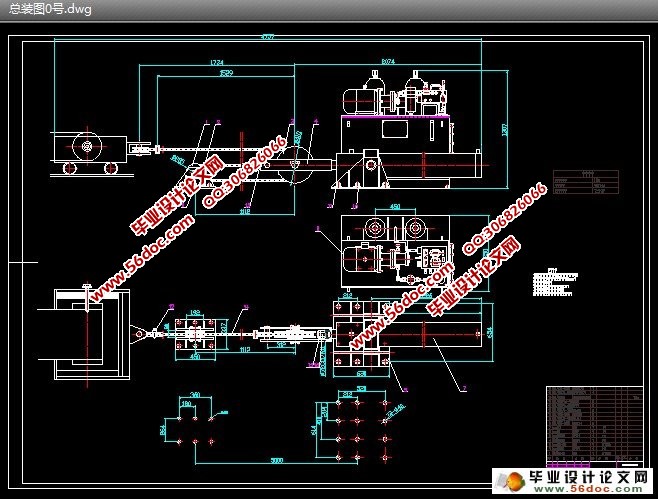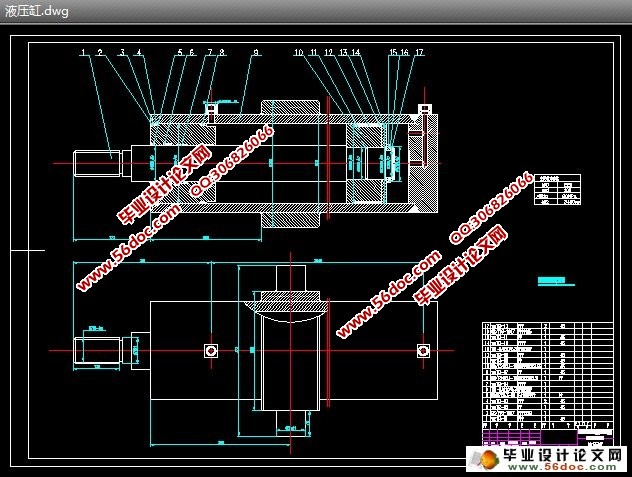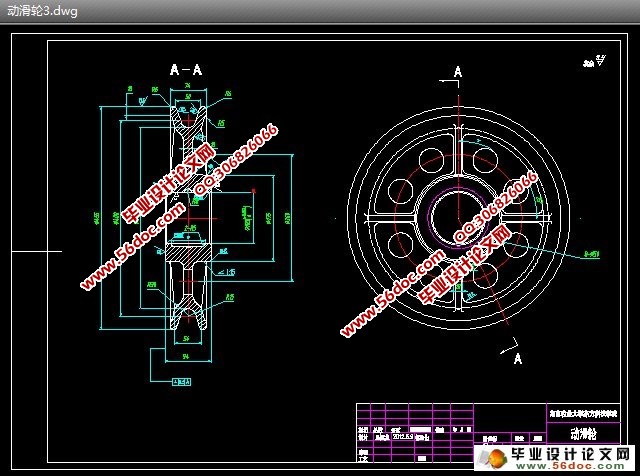带式运输机液压张紧装置设计
无需注册登录,支付后按照提示操作即可获取该资料.
带式运输机液压张紧装置设计(选题审批表,任务书,开题报告,中期检查表,论文说明书23000字,CAD图9张)
摘 要:张紧装置是带式输送机不可缺少的部分,是影响输送带动张力的主要部件之一,它直接关系到带式输送机的安全运行及使用寿命,对于大运量、长距离等大型带式输送机的正常运行而言尤为重要。
本带式输送机液压张紧装置的设计是在吸收国、内外输送机张紧技术的基础上,根据国内带式输送机的运行特点及要求研制的一种新型液压张紧装置。采用比例控制技术及可靠性较高的可编程控制技术,可以对张紧力进行多点控制,根据不同工作情况随时调节张紧力的大小。自动实现在胶带机在启动时提供较大张力(约为正常运行时张力的1.5倍),正常运行时较小张力。使胶带在工作过程中有科学合理的张力,即防止了胶带启动时打滑,又可使胶带机正常运行不在过紧状态。利用该装置可以延长胶带的寿命,大大节约输送机的运行成本。本设计中,利用滑轮机构增大了张紧行程,避免使用行程较长的液压缸,减少了制造液压缸的难度。液压系统中采用蓄能器,可以最大限度的吸收液压冲击,减小对负载变化对胶带的冲击,提高胶带的使用寿命。
关键词:带式输送机;液压张紧装置;自动控制;
The Design of The Hydraulic Anchor
Abstract: The stretching device is the belt conveyer essential part, is affects the transportation to lead one of tensity major components, its direct relation belt type conveyer's safe operation and the service life, speaking of the great transportation amount, the long distance and so on large-scale belt conveyer's normal operation especially important.
This belt conveyer hydraulic pressure stretching device's design is in the absorption country, the inside and outside conveyers tighten in the technical foundation, according to domestic belt conveyer's movement characteristic and request development one kind of new hydraulic pressure stretching device. Uses the proportional control technology and the reliability high programmable control technology, may carry on the multi-spot control to the tensioning force, momentarily adjusts the tensioning force according to the different working condition the size. Realizes automatically in the adhesive tape machine when the start provides the big tensity (approximately for normal operation when tensity 1.5 times), when normal operation small tensity. Enables the adhesive tape to have the science reasonable tensity in the work process, namely prevented the adhesive tape started when to slip, might also cause the adhesive tape machine normal operation not at the tight condition. May lengthen adhesive tape's life using this equipment, saves conveyer's run cost greatly. In this design, increased using the pulley organization has tightened the traveling schedule, avoided using the traveling schedule long hydraulic cylinder, reduced has made hydraulic cylinder's difficulty. In the hydraulic system uses the accumulator, may the absorption line shock maximum limit, reduce to the variation of load to the adhesive tape the impact, enhances adhesive tape's service life.
Keywords : Belt-type conveyer, full automatic hydraulic tension station , proportional control, programmable control
带式输送机张紧装置的主要作用
带式输送机在工作过程中,输送带会由于拉力和惯性的作用发生蠕变,导致输送带变长松弛而无法工作。输送带张紧装置是保证输送带能持续正常工作的重要组件。张紧装置在带式输送机中具有以下作用[2]:
(1)保证带式输送机驱动滚筒分离点的足够张力,防止输送带打滑,从而将驱动装置传递的摩擦牵引力传递给输送带,以带动输送机的正常运转。
(2)保证承载分支最小张力点的必须张力,限制输送带在托辊之间的垂度,防止物料垂直跳动对托辊形成冲击而导致电机能量的损失及物料的洒落现象。
(3)在输送带、传动滚筒等部件维修时释放输送带中的张紧力。




目 录
摘要 1
1 前言 2
1.1 带式输送机张紧装置的主要作用 2
1.2 张紧装置的类型及发展现状 3
1.2.1 固定张紧装置 3
1.2.2 重锤张紧装置 4
1.2.3 液压张紧装置 4
1.3 张紧装置发展趋势 4
2 整体方案设计 4
2.1 主要设计要求 5
2.2 方案选择 5
2.2.1 方案一 5
2.2.2 方案二 6
2.3 方案对比及确定 6
2.4 系统主要参数确定 7
3 液压缸设计 7
3.1 液压缸主要零件设计 7
3.1.1 缸筒选择 7
3.1.2 缸筒材料 8
3.1.3 缸筒计算 8
3.1.4 活塞杆 10
3.1.5 活塞杆的计算 11
3.1.6 活塞杆的导向套、密封和防尘 12
3.1.7 活塞 12
3.2 密封圈、防尘圈的选用 13
3.3 液压缸的类型和安装形式 14
3.4 耳轴的安装 14
3.5 液压缸支架设计 15
4 确定液压泵及配套电机 15
4.1液压泵的选用 15
4.1.1 液压泵在系统中的作用 15
4.1.2 液压泵的分类 16
4.1.3 选用液压泵的原则和根据 16
4.1.4 液压泵的主要性能参数 16
4.2电动机的选用 17
5 确定液压系统元件、辅件 18
5.1液压系统中液压元件选取 18
5.2确定液压辅件 19
5.2.1 蓄能器的选用 20
5.2.2 过滤器的选用 21
5.2.3 液压管路的设计 22
6 液压泵站设计 23
6.1液压泵站分类及特点 23
6.2油箱极其辅件 23
6.2.1 油箱的用途和分类 23
6.2.2 油箱的构造和设计要点 24
6.2.3 油箱容积确定 25
6.3液压油箱的结构设计 25
7液压工作介质的选用 30
7.1对液压工作介质的主要要求 30
7.2对液压工作介质的选用 31
8液压系统的安装、使用和维护 31
8.1液压系统的安装、试压和调试 31
8.1.1 液压系统的安装 31
8.1.2 液压元件的安装 35
8.1.3 管路的安装与清洗 36
8.2试压 36
8.3调试 36
8.4液压系统常见故障诊断与排除 37
8.5本装置的安装与使用操作 38
8.5.1 安装 38
8.5.2 运行前的准备工作 38
8.5.3 液压系统的试运行 38
8.5.4 注意事项 38
8.5.5 安全保护装置及事故处理 38
8.5.6 保养与维修 39
9结论 39
参考文献 40
致谢 40
